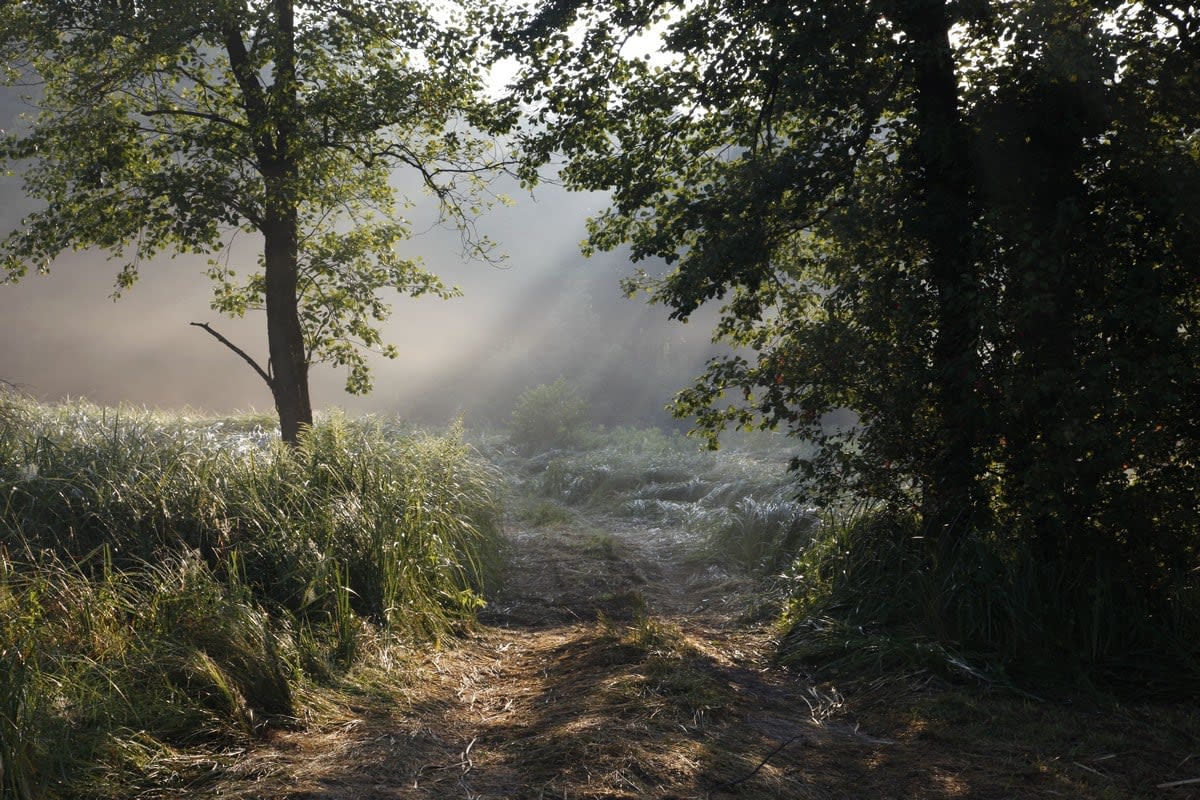Janez Bogataj
digitalni tisk na arhivski papir / digital print on archival paper
70 x 100 cm
30 x 40 cm
For English version please scroll down.
O SERIJI
Prav veliko se ni spremenilo v krajinski fotografiji Janeza Bogataja, če motivni svet barvne fotografske serije Sonata za sonce in meglo primerjamo z zgodnejšimi črno-belimi. Tih in miren svet povsem nepomembnega rastja, samo trave, šavje in drevesa v odnosu z okolico ter avtor, ki elemente krajine spreminja v metafore.[1]
Tvorbo slednjih je Aristotel razglasil za veliki dar, ki ga imajo pesniki[2]. Avtor svoje krajinske serije poimenuje z naslovi s področja pesništva in glasbe. Pastorala[3] je naslov leta 2004 objavljene monografije s črno-belimi krajinami, z barvno Sonato za sonce in meglo pa nadaljuje z glasbenimi prispodobami.
Sonata (iz sonare, ital. zveneti) je glasbena kompozicija za enega ali manjše število instrumentov. Navadno jo sestavljajo trije ali štirje samostojni stavki, ki se tukaj ujemajo s štirimi sklopi fotografij, nastalih v letu 2009 in 2010 (Bohinj; Notranjska, Gorenjska, Koroška; Ljubljansko barje; Bela krajina). V Bogatajevem vizualnem skladanju sta osrednji glasbili sonce in megla. S podob zazvenijo tišina, samota in nekakšen panteistični kozmični red, ki boga istoveti s svetom, z naravo.
Notni zapisi skladb za sonce in meglo razkrivajo kompozicijska načela komponiranja:
veliko prostorskih planov, asketsko prazne ali nasičene, največkrat odprte, diagonalne statične kompozicije, bogastvo uporabljenih prostorskih ključev, ki prispevajo k iluziji prostora. Barvna perspektiva, uporaba komplementarnih barv, s katero barve poudarijo druga drugo. Sence, ki igrajo pomembno vlogo pri določanju globine prostora ter dramatičnosti, prekrivanje oblik in z njo prostorska gradacija. Uporaba likovnih spremenljivk: uravnotežene smeri (aktivne diagonale, pasivne horizontale ter vertikale, ki pomenijo rast in življenje), odnosi malo-mnogo, prazno-polno, redko-gosto, prazno-nasičeno... Podobe so polne likovnih kontrastov. Prevladuje zgornji rakurs oziroma pogled iz zgornjega kota. Posneti objekti se zdijo inferiorni, prepuščeni usodi, nemočni, obenem pa glavni igralci drame, ki se odvija pred nami. Velikokrat je uporabljen teleobjektiv, ki omenjeni učinek v fokus postavljenega objekta še poveča. Povsem navadne rastline postanejo protagonisti , ki sodelujejo v ponekod skorajda baročno polni, a kljub temu enostavni, harmonični, uravnoteženi in prepričljivi prostorski iluziji.
Bogatajeva dela pričajo, kako tesno je povezan z lastnim bistvom oziroma, kako nemogoče je iskrenemu ustvarjalcu prikriti sebe. Fotograf, ki je po delu fotoreporterja na Mladini (1979 – 1988) petnajst let posvetil skoraj izključno branju knjig, ima rad naravo, enostavnost in samoto.
Njegove fotografije spomnijo na zenovsko umetnost, ki poudarja preprostost in pomembnost narave. Estetiko zena označujeta termina wabi in sabi. Amorfna koncepta vsebujeta smisel za enostavnost, melanholijo, samoto, naravnost nepopolnost in čas. Velja, da je obrabljen kmečki vrč lepši od starega skrbno rokodelsko izdelanega vrča, saj drugi stimulira le čute, medtem ko prvi vzpodbuja razum in emocije, da kontemplirajo bistvo resničnosti.
Saj ne da bi avtor zavestno komponiral v zenovski maniri, a njegova umetnost je tako blizu značilnostim wabi sabija, da se primerjave kar same vzpostavijo.
Bistvo filozofije Zena je meditacija in ko avtor fotografira, se zdi kot da meditira. Zavest se osredotoča le na zgodbe v naravi in šele najdba pravega motiva, ga zamakne iz tega stanja.
Bogatajeva krajina pa je zenovsko občutena tudi zato, ker si današnji opazovalec, ki je naravo na fotografijah videl že tolikokrat, da velikokrat naveličan, le še odvrne pogled, zato da bi občutil te podobe, mora vzeti čas in malo »posedeti pod drevesom«, da do njega lahko prodre osebno pojmovanje oziroma svetovni nazor, ki ga avtor podaja s pretanjenimi kompozicijskimi ključi.
Kako postanejo razsvetljene trave in drevesa
(Zenovski koan)
V obdobju Kamakura je Shinkan najprej 6 let preučeval Tendai budizem, nato pa 7 let še Zen. Zatem se je odpravil na Kitajsko in tam kontempliral o Zenu naslednjih 13 let.
Ob vrnitvi na Japonsko so se mnogi želeli z njim pogovarjati in so ga spraševali nepomembne stvari. Toda ko je Shinkan sprejel obiskovalce, kar se je zgodilo le kdaj pa kdaj, je le redko odgovarjal na njihova vprašanja.
Nekega dne je nek 50 letni študent »razsvetljenstva« rekel Shinkanu: »Tendaisko šolo misli preučujem že vse od rojstva, a nekaj je, kar nikakor ne morem razumeti. Tendai trdi, da bodo celo trave in drevesa postala razsvetljena. Zame je to zelo čudno.«
»Kakšen smisel ima razpravljati, kako bodo celo trave in drevesa postala razsvetljena?« je vprašal Shinkan. »Vprašanje je, kako lahko ti postaneš takšen. Si kdaj pomislil na to?«
»Nikoli,« ga je občudoval starec.
»Potem pa pojdi domov in naredi tako,« je zaključil Shinkan.
Renata Štebih
[1] Jolanda Petelinkar: Janez Bogataj – Fotografske metamorfoze krajine; razstavni katalog, Moderna galerija Ljubljana, 1992
[2] Aristoteles: Poetika. Cankarjeva založba, 1982
[3] lat. Pastorale.; lirsko-epsko delo z motivi idilične, pastirske ljubezni; pastirska igra
ABOUT THE SERIES
Little has changed in the landscape photography of Janez Bogataj if we compare the motif world of the colour photography series Sonata for the sun and fog with the earlier black-and-white work. The still and silent world of thoroughly insignificant plants, nothing but grass, thicket and trees in relation to the environment, and the author who changes the landscape elements into metaphors.[1]
Aristotle proclaimed the latter to be a great gift poets have[2]. The author names his landscape series after titles borrowed from poetry and music. The Pastoral[3] is the title of a monograph with black-and-white landscapes from 2004, and the Sonata the sun and fog in colour continues with music metaphors.
A sonata (from sonare, Ital. to sound) is a musical composition for one or several instruments, yet not many. It usually consists of three or four separate movements, here they coincide with four sets of photographs made in 2009 and 2010 (Bohinj; Notranjska, Gorenjska, Koroška; Ljubljansko barje; Bela krajina). The primary instruments in Bogataj's visual composing are the sun and fog. The images sound silence, solitude and a pantheistic cosmic order which equates God with the world, with nature.
The notation of the compositions for the sun and fog is revealed in the principles of composition: picture planes, ascetically empty or saturated, in most cases open, diagonal static compositions, an abundance of applied spatial keys, which add to the illusion of spatiality. Colour perspective, the application of complementary colours which makes colours emphasise one another. Shadows, which play an important role in determining depth of field and dramatic quality, overlapping of shapes and consequent spatial gradation. The application of art variables: balancing directions (dynamic diagonals, passive horizontals, and verticals which signify growth and life), the relations little-much, empty-full, thin-thick, empty-saturated ... The images are teeming with contrasts. The upper angles of view prevail. The photographed objects seem inferior, left to their own destiny, impotent, yet they are at the same time the protagonists in the drama which unfolds before our eyes. Often used telephoto lenses, which further intensifie the said effect of the focused object. Quite ordinary plants become protagonists which participate in sometimes almost baroque, yet nevertheless simple, harmonic, balanced and persuasive spatial illusion.
Bogataj's works testify how closely he is connected with his own essence or how impossible it is for a sincere artist to conceal himself. After the photographer ceased to work as a photo-reporter for the magazine Mladina (1979 – 1988), he spent fifteen years almost exclusively for reading books, he likes nature, simplicity and solitude.
His photographs are reminiscent of Zen art, which emphasises simplicity and the importance of nature. Zen aesthetics is defined by the terms wabi and sabi. These amorphous concepts comprise the taste for simplicity, melancholy, solitude, naturalness, incompleteness and impermanence. Thus a well-used rustic jug is more beautiful than an old, meticulously made jug, since the latter stimulates only the senses, while the former stimulates the mind and the emotions to contemplate on the essence of reality.
The authordoes not, however, intentionally compose in a Zen manner, yet his art is so close to the attributes of wabi-sabi that one cannot help drawing parallels.
The essence of Zen philosophy is meditation, and when the author is taking photographs it seems as if he is meditating. His consciousness is concentrating only on stories in nature and he is pulled from this state of mind only when he finds the right motif.
Bogataj's landscape is felt according to Zen also because modern viewers, who have seen nature in photographs so many times that they are often fed up, avert their gazes; in order to feel these images they have to take some time and »sit for a while under the tree«, so they can absorb the personal understanding or worldview the author offers us with subtle compositional keys.
How Grass and Trees Become Enlightened
(koan)
During the Kamakura period, Shinkan studied Tendai buddhism for six years and then studied Zen seven years. Then he went to China and there contemplated Zen for a further thirteen years.
When he returned to Japan, many people wished to speak to him and asked him unimportant questions. But when Shinkan received visitors, which was not frequent, he seldom answered their questions.
One day a fifty-year-old student of »enlightenment« said to Shinkan: »I have studied the Tendai school of thought since I was born, but there is one thing I cannot understand. Tendai claims that even grass and trees will become enlightened. This seems very strange to me.«
»What is the use of discussing how even grass and trees will become enlightened?« asked Shinkan. »The question is how you yourself can become such. Have you ever thought about it?«
»Never,« said the old man admiringly.
»Then go home and do it,« Shinkan concluded.
Renata Štebih
[1] Jolanda Petelinkar: Janez Bogataj – Photographic metamorphoses of a landscape; exhibition catalogue, Modern Gallery Ljubljana, 1992
[2] Aristotle: Poetics. Cankarjeva založba, 1982
[3] Lat. Pastorale.; lyrical epic work with motifs of idyllic rural love; herdsmen's play


